By Sue Puetz
Life for me as a photographer began in 2014 when we moved into a motorhome and toured the USA, sans home base. Newly retired, this was the first time I could plan and commit to photo shoots in remote areas. I’ve always had a camera but this new adventure amplified my interest in photography with a focus on photojournalism.
My favorite subject is wildlife, capturing images in our national parks along our treks between Texas and Montana. When traveling through the Rocky Mountains I like to follow the bears, moose, elk, bald eagles, hawks and more. While in Florida one winter I spent time photographing burrowing owls with “The Owl Lady.” My preferred camera is my Nikon Z6 mirrorless camera with several lenses but the wilder wildlife nudged me to acquire a Sony RX10 with a 600mm lens.

Inspired by a neighbor, I mounted an owl box onto an oak tree in my backyard three years ago. The first year we had no visitors and the second year an owl couple had only a short stop over. We later discovered that the box was infested with ants. This past winter I successfully hosted a Screech Owl mated pair in my back yard and spent hours learning their habits. I feared the worst after my trail camera captured several visits by a fox, a raccoon and cats and the male went missing.

I had read that All Things Wild Rehabilitation (ATW) was nearby and called them for help. Upon ATW's direction, I covered my owl box with a towel, loaded it into my car and headed their way. To my surprise, there was one adult and three owlets in the box and all were fat and healthy. ATW had an orphaned fledgling Screech who needed a family to help him learn to fly so I adopted it.

ATW was happy because they received four owls and released five. My success was even greater – I went in with (what I thought was) one owl and came home with five. Back home the male owl reappeared and helped raise the four owlets. While I was still nurturing my owl family of six, ATW received another orphaned Screech that needed a home. I adopted that one too and the owl family expanded to seven.
On my first visit to ATW I was so excited with the news of four owls, I captured the moment with my iPhone while they were examining my female and each owlet. As I was leaving I asked if I could come back to take more photographs and they agreed with some apprehension. They had a history with a photographer who was in it to boost her own business.

ATW is a not-for-profit organization and I became an ardent volunteer photographer for their cause. At the onset of spring and through the summer, they receive many small animals who have been injured or orphaned.
My first ‘job’ with them was to record the release of 14 opossums back into the wild. Watching these critters exit their crate with great caution, sniff the air of freedom and finally trot off into the wild was exhilarating. I have been on other releases with them for Great Horned Owls, and many squirrels and raccoons. I also accompanied a rescue of a raccoon who had fallen through the ceiling of an office building's second story.

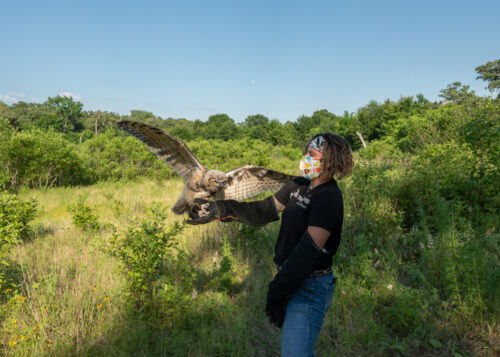
As I spend more time with ATW, I learn just how necessary, orderly and tedious their job is. They have a white board with explicit instructions for mixing different formulas by ratio of protein-to-fat for each of cotton tails, opossums, squirrels, skunks, foxes, raccoons and fawns. On each of the animal crates is an instruction board with what to feed and how often, sometimes every hour for the youngest. ATW is gifted with employees and volunteers who foster animals in need of round-the-clock attention.
At the outset it was easy for me to get wrapped up in the cuteness of ATW's charges. However, I hope to tell ATW's story as I record an employee feeding a week-old squirrel via a nipple-syringe, the vet tech wrapping the wing of an injured hawk or a volunteer in the kitchen chopping a tub full of fresh vegetables for the fawns. I have willingly shared images and created videos for them to publish on their social media accounts and in their monthly newsletter Paws ‘n Claws. I drop in at ATW at least once a week and always wish for more.
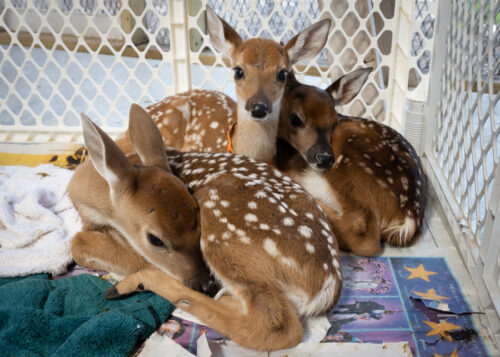
This process has been life changing for me. I have learned how to examine the crop of a bird to tell if it is malnourished. I have learned that when a baby squirrel is tubed (tiny tube inserted through the side of his mouth, reaching to its stomach) with a syringe, you can watch the ‘milk line’ on its stomach to tell when he’s had enough. I’ve learned that it’s safer to pick up a skunk by tucking his tail up under his abdomen with the palm of your hand. By watching an employee teaching a pair of crows I have learned that crows are intelligent, have burial ceremonies for their loved ones and recognize their given names.
ATW’s strongest message is: “Avoid imprinting a wild animal. Do not pick up a wild animal, enjoy it until you can’t and then expect it to adjust back into the wild. They can’t.” Some animals cannot be released back into the wild because of an irremediable condition, such as head trauma or a spinal injury. Those who pose no threat to humans may stay on at ATW as ambassadors and are then participants in ATW’s education programs at their center or in schools.
My goal with ATW is to provide images and videos they can use in their plea for financial support. In a normal year ATW actively participated in fairs and hosted their own open house. However, this year has not allowed normal exposure to potential benefactors. I hope I have helped keep their efforts and needs in the spotlight. I live only 20 minutes from the ATW center so I can be there with very little notice.
To my fellow photographers, I encourage you to find a cause that your talent can serve. There are animals, humans, forests and parks who would welcome your help.
Sue Puetz is a born and raised Texan and when she was a child she occasionally rode a horse to school. Sue loves to learn and teach and describes her curiosity and passion for adventure as insatiable. Her love for photography is just as fervent. Sue's interest in photographing wildlife includes her grandchildren. To view more of Sue's work, go here. To learn more about All Things Wild Rehabilitation, go here.
